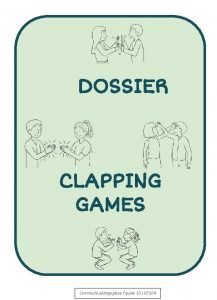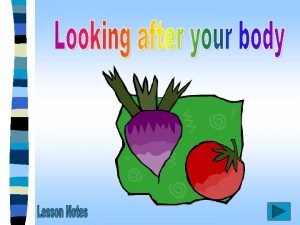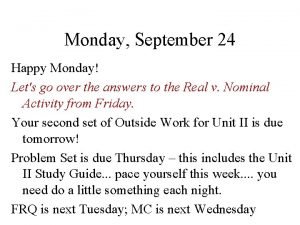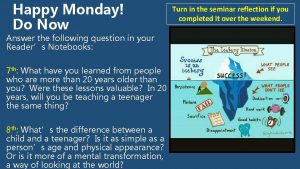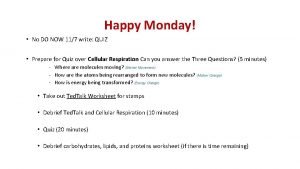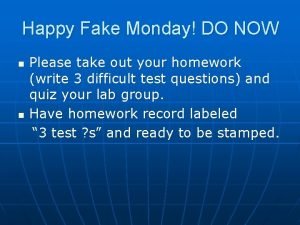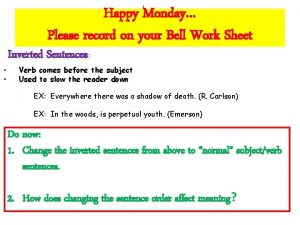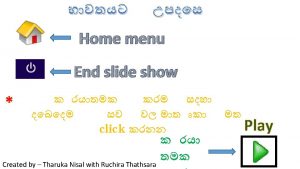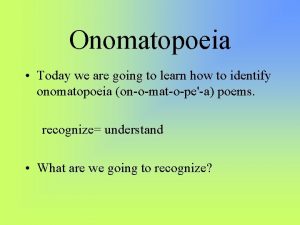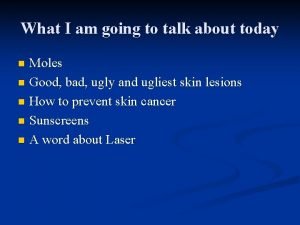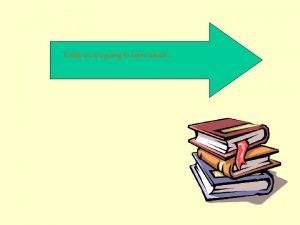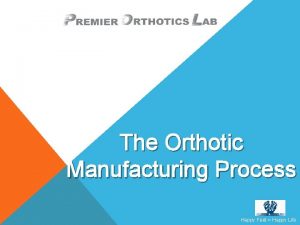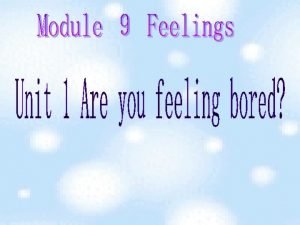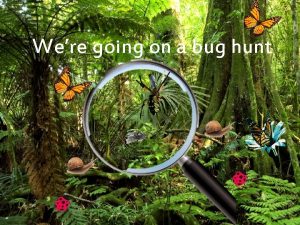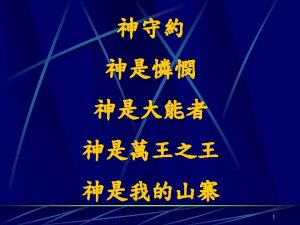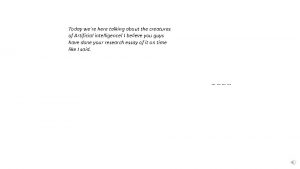Happy Monday Today were going to start talking












































- Slides: 44

Happy Monday!! • Today we’re going to start talking about cells – YEAH! It’s going to be a real CELL -abration!! • You will need paper for notes and your Unit 2 Learning Targets

CELL THEORY 1. All living things are ____________. MADE OF CELLS 2. Cells are the basic unit of STRUCTURE FUNCTION ______ & _______ in an organism. life (cell = basic unit of _______) 3. Cells come from the reproduction of ______ cells existing Cell image: http: //waynesword. palomar. edu/lmexer 1 a. htm

How are these cells the same? How are they different?

10/5 warmup • Make a venn diagram to compare and contrast prokaryotic and eukaryotic cells.

Levels of organization of cells • Cell – Smallest level – Can be very specialized, i. e. . Nerve cells, bone cells • Tissues – A group of similar cells that perform a particular function – i. e. muscle tissue, cartilage

Levels of organization of cells cont. . • Organs – A group of tissues working together to perform a task – I. e. a bicep muscle, your stomach • Organ System – Most organs need to work together to complete a specialized task – Is. Circulatory system, nervous system

• Golgi apparatus: • http: //www. youtube. com/watch? v=cn. K 7 RT 1 q 0 b. A&feature=related • Plasma membrane: • http: //www. youtube. com/watch? v=D 1 KXib LIOGY&feature=related

Chapter 7 -2 Cell Structure and Function Nucleolus Nuclear envelope Rough endoplasmic reticulum Golgi apparatus Ribosome (attached) Ribosome (free) Cell Membrane Mitochondrion Smooth endoplasmic reticulum Centrioles Image from: © Pearson Education Inc, Publishing as Pearson Prentice Hall; All rights reserved

CELL MEMBRANE (also called plasma membrane) • Barrier that surrounds the outside of the cell Outside of cell Proteins Carbohydrate chains Cell membrane Inside of cell (cytoplasm) Protein channel Lipid bilayer Image from: © Pearson Education Inc, Publishing as Pearson Prentice Hall; All rights reserved

WHAT DOES IT DO? Images from: http: //vilenski. org/science/safari/cellstructure/cellmembrane. html http: //www. mccc. edu/~chorba/celldiagram. htm Acts as a boundary Controls what enters and leaves cell

CYTOPLASM (Between nucleus and cell membrane) Image from: http: //vilenski. org/science/safari/cellstructure/cytoplasm. html Organelles suspended in gel-like goo ORGANELLEsmall structure with a specific function (job) Image from: http: //faculty. stcc. tn. us/jiwilliams/labprojectsmenu. htm

NUCLEUS Largest organelle in animal cells (remember which type of cells have a nucleus and which do not? ) Image from: http: //www. mccc. edu/~chorba/celldiagram. htm

NUCLEUS Surrounded by NUCLEAR ENVELOPE (also called NUCLEAR MEMBRANE) DOUBLE MEMBRANE Image from: http: //www. agen. ufl. edu/~chyn/age 2062/lect_06/5_11. GIF

NUCLEUS NUCLEAR PORES Openings to allow molecules to move in and out of nucleus Image from: http: //www. emc. maricopa. edu/faculty/farabee/BIOBK/Bio. Book. CELL 2. html

WHAT DOES IT DO? Contains genetic material (DNA) DNA is scrunched up as CHROMOSOMES in dividing cells DNA is spread out as CHROMATIN in non-dividing cells

WHAT DOES IT DO? Control center of cell Image from: Genetic code tells the cell’s parts what to do Image from: http: //web. jjay. cuny. edu/~acarpi/NSC/12 -dna. htm

NUCLEOLUS Image from: http: //lifesci. rutgers. edu/~babiarz/histo/cell/nuc 3 L. jpg Dark spot in nucleus = NUCLEOLUS _____ Makes RNA for ribosomes

CYTOSKELETON Image from: http: //anthro. palomar. edu/animal/default. htm • Helps cell maintain shape • Help move organelles around Made of PROTEINS: MICROFILAMENTS (Actin) & MICROTUBULES (Tubulin) Image from: © Pearson Education Inc, Publishing as Pearson Prentice Hall; All rights reserved

CENTRIOLES Appear during cell division to guide chromosomes apart

MITOCHONDRION (plural=MITOCHONDRIA) Look like “little sausages” Image from: http: //instructional 1. calstatela. edu/dfrankl/CURR/kin 150/Images/mitochondria. jpg

MITOCHONDRIA Surrounded by a DOUBLE membrane Has its own DNA Folded inner membrane increases surface area for more chemical reactions Image from: http: //www. biologyclass. net/mitochondria. jpe

MITOCHONDRIA…. . Come from cytoplasm in the EGG cell. Which means…… You inherit your mitochondria from your mother! http: //www. wappingersschools. org/RCK/staff/teacherhp/johnson/visualvocab/p 14%5 b 1%5 d. jpg

WHAT DOES Mitochondria DO? Images from: http: //vilenski. org/science/safari/cellstructure/mito. html http: //www. estrellamountain. edu/faculty/farabee/biobk/Bio. Book. CHEM 2 “Powerplant of cell” Burns glucose to release energy. The cell uses this energy for growth, development, movement. Stores energy as ATP Image by: Riedell

RIBOSOMES • Made of PROTEINS and RNA • Protein factory for cell Join amino acids to make proteins Image by: RIedell Image from: http: //www. ust. hk/roundtable/hi-tech. series/1_b 1. jpg

RIBOSOMES Image from: http: //www. biologyclass. net/endoplasmic. jpe Can be attached to Rough ER OR free in cytoplasm Image from: http: //www. mccc. edu/~chorba/celldiagram. htm

ENDOPLASMIC RETICULUM Network of hollow membrane tubules 2 KINDS: SMOOTH or ROUGH Image from: http: //www. agen. ufl. edu/~chyn/age 2062/lect_06/5_10 B. GIF

ROUGH ENDOPLASMIC RETICULUM (Rough ER) Animation from: http: //vilenski. org/science/safari/cellstructure/er. html Makes membrane proteins and proteins for export out of cell Image from: http: //www. biologyclass. net/endoplasmic. jpe

ROUGH ENDOPLASMIC RETICULUM (ER) • Has RIBOSOMES attached • Proteins are made on ribosomes and inserted into Rough ER to be modified and transported Image from: http: //fig. cox. miami. edu/~cmallery/150/cells/ER. jpg

SMOOTH ENDOPLASMIC RETICULUM (smooth ER) Image from: http: //www. science. siu. edu/plant-biology/PLB 117/JPEGs%20 CD/0073. JPG • Has NO ribosomes attached • Has enzymes for special tasks

SMOOTH ENDOPLASMIC RETICULUM (smooth ER) Image from: http: //www. accs. net/users/kriel/chapter%20 eight/smooth%20 er. gif • Makes membrane lipids (steroids) • Regulates calcium (muscle cells) • Destroys toxic substances (Liver)

GOLGI APPARATUS (BODY) Image from: http: //vilenski. org/science/safari/cellstructure/golgi. h Image from: http: //www. rsbs. anu. edu • Pancake like membrane stacks Modify, sort, & package molecules from ER for storage OR transport out of cell Image from: http: //vilenski. org/science/safari/cellstructure/golgi. h

LYSOSOMES Animation from: http: //vilenski. org/science/safari/cellstructure/lysosomes. html Membrane bound sacs that contain PROTEINS called digestive enzymes Digest food, unwanted molecules, old organelles, cells, bacteria, etc

LYSOSOMES See lysosomes in action: Image modified from: http: //www. people. virginia. edu/~rjh 9 u/lysosome. html

LYSOSOMES See LYSOSOME MOVIE Image from: http: //www. people. virginia. edu/~rjh 9 u/lysosome. html

FLAGELLA & CILIA Aid in cell movement Made of PROTEINS called MICROTUBULES (9 + 2 arrangement) Image from: http: //www. stchs. org/science/courses/sbioa/metenergy/flagella. jpg

WHAT’S SPECIAL ABOUT PLANT CELLS? • • Cell wall HUGE vacuoles Chloroplasts No centrioles Plant vs Animal cells

CELL WALL http: //www. windows. ucar. edu/kids_space/images/brick_wall. jpg Supports and protects cell http: //web. jjay. cuny. edu/~acarpi/NSC/13 -cells. htm Outside of cell membrane Made of carbohydrates & proteins CELLULOSE Plant cell walls are mainly _______

VACUOLES Image from: http: //www. biologycorner. com/resources/plant_cell. gif Storage space http: //library. thinkquest. org/3564/Cells/cell 93. gif

VACUOLES Image from: http: //www. metoliusfriends. org/csca/images/tupperware. jpg • Storage space for WATER, salts, proteins (enzymes), carbohydrates, and waste Vacuoles SMALL in ANIMAL CELLS NO VACUOLES IN BACTERIA

Contractile vacuoles control excess water in cells (HOMEOSTASIS) http: //www. microscopy-uk. org. uk/mag/imgjun 99/vidjun 1. gif 1

CHLOROPLASTS http: //www. seorf. ohiou. edu/~tstork/compass. rose/photosynthesis/chloro_sun_bathing. gif • Use energy from sunlight to make own food (glucose) http: //stallion. abac. peachnet. edu/sm/kmccrae/BIOL 2050/Ch 1 -13/Jpeg. Art 1 -13/04 jpeg/04 -28_chloroplasts_1. jpg

CHLOROPLASTS http: //media. pearsoncmg. com/bc/bc_campbell_essentials_2/cipl/04/HTML/source/04 -17 -chloroplast-nl. htm • Surrounded by DOUBLE membran • Thylakoid membrane sacs contain enzymes for photosynthesis • Contains own DNA

Figure 7 -5 Plant and Animal Cells Section 7 -2 Smooth endoplasmic reticulum Vacuole Ribosome (free) Chloroplast Ribosome (attached) Cell Membrane Nuclear envelope Cell wall Nucleolus Golgi apparatus Nucleus Mitochondrion Rough endoplasmic reticulum Plant Cell Go to Section:

DIFFERENCES IN ANIMAL CELLS, PLANT CELLS, AND BACTERIA ANIMAL CELL PLANT CELL BACTERIA Eukaryotes Prokaryotes Cell membrane Nuclear membrane NO cell wall Cell wall made of CELLULOSE Cell wall made of PEPTIDOGLYCAN Has ribosomes DNA in multiple chromosomes DNA is a single circular ring CYTOSKELETON Small vacuoles Really big vacuole NO vacuoles Has lysosomes NO lysosomes Has centrioles NO chloroplasts Chloroplasts NO chloroplasts SMALLER SMALLEST NO nuclear membrane
 Lve
Lve You are happy i am happy
You are happy i am happy Was were going to future in the past
Was were going to future in the past Are we talking today
Are we talking today Econmovies episode 6 back to the future worksheet answers
Econmovies episode 6 back to the future worksheet answers Happy monday jr password
Happy monday jr password Happy monday answer key
Happy monday answer key Happy monday quiz
Happy monday quiz Happy monday november 1st
Happy monday november 1st Happy monday welcome back
Happy monday welcome back Response to happy monday
Response to happy monday Happy december good morning
Happy december good morning Fake monday
Fake monday Happy monday hope you had a great weekend
Happy monday hope you had a great weekend Happy monday november 1st
Happy monday november 1st Happy monday quizzes
Happy monday quizzes Econmovies 3 monsters inc. answer key
Econmovies 3 monsters inc. answer key Good afternoon happy monday images
Good afternoon happy monday images Do not confuse theme with a story's
Do not confuse theme with a story's Happy wednesday
Happy wednesday Happy monday team
Happy monday team Happy monday answer key
Happy monday answer key Good morning pics
Good morning pics Passive voice past perfect
Passive voice past perfect If you are going through hell, keep going
If you are going through hell, keep going Today we are going to learn
Today we are going to learn Today i'm going to
Today i'm going to Today we are going to
Today we are going to Where are you going today
Where are you going today Today we are going to learn about
Today we are going to learn about Today i am going to talk about
Today i am going to talk about I am going to talk
I am going to talk Today we are going to talk about
Today we are going to talk about Today we are going
Today we are going Are we having class today
Are we having class today Today we are going to learn
Today we are going to learn Happy feet happy life
Happy feet happy life Sad happy bored
Sad happy bored Happy sad hungry
Happy sad hungry Happy sad angry surprised
Happy sad angry surprised Happy friday today
Happy friday today Today meeting or today's meeting
Today meeting or today's meeting Today's lesson or today lesson
Today's lesson or today lesson Characteristic of fingerprint
Characteristic of fingerprint Today's lesson or today lesson
Today's lesson or today lesson
